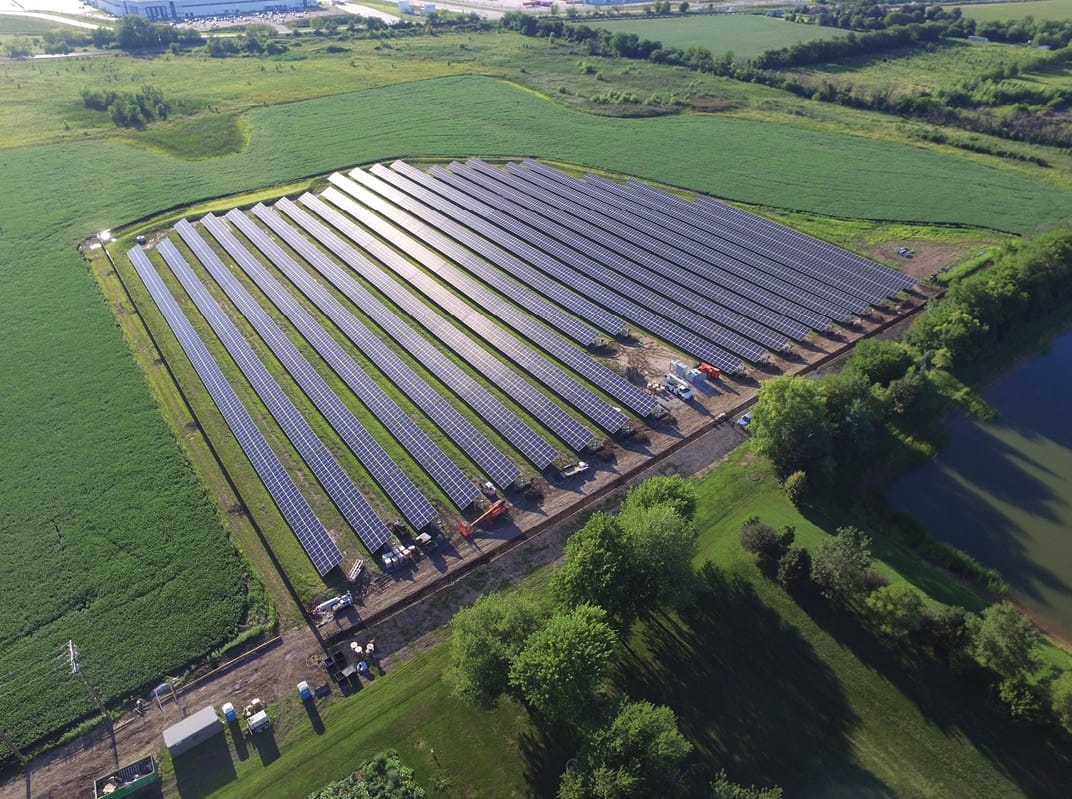How you select your energy source is your prerogative. But in Illinois, the movement toward electrifying with clean energy is proving to be a cost effective one.
Each year the state increases its renewable energy portfolio, moving away from its traditional fossil fuel production and consumption. As of now, the state has installed 2,201 megawatts (MW) of solar and 7,037 MW of wind capacity.
Around the state, projects like Summit Ridge Energy and Commonwealth Edison’s (ComEd) Speedway Solar have begun collecting its 2.495 MW of solar power, while Swift Current Energy’s Double Black Diamond Solar Project gears up for commercial operation in 2024.
These projects join the growing number of solar developments taking place in the state over the past five years with no signs of slowing down.
“While we saw a significant growth in community solar in 2021, there’s a bunch of projects that are in development right now but have not come online just yet,” says ComEd VP of Strategy and Energy Policy Scott Vogt. “One of the things that makes Illinois attractive to developers and customers for adopting solar is the significant amount of incentives that are available through the state’s renewable portfolio standard program.”
The Renewable Portfolio Standard program requires 25% of electric sales be made up of renewables by 2025. Through the program customers and businesses alike can earn incentives and electric bill credits for the solar energy they produce.
The transition to clean energy, though beneficial, offers utility providers the opportunity to educate consumers on how connecting to a renewable grid or installing a solar system can save on power bills.
ComEd provides electricity to over 4 million customers in Northern Illinois, roughly 70% of the state’s population. Although ComEd does not build or install solar panels, the company can play a vital role in informing its customers that a renewable switch doesn’t necessarily equate to an expensive switch.
In 2022, the company received 19,292 applications from residents, communities, businesses, industrial and utility scale users to connect to its solar grid. Just six months into 2023, over 9,330 applications have been received. Data shows that residential, community and commercial users, respectively, lead the transition. The company created its solar calculator application in 2017, which encompasses marketplace dynamics, cost of solar systems, availability of tax credits and state incentives. By plugging in a home address a customer can learn how much power a home is using and provide an estimate of how much solar production can come from its roof. In turn these estimates show an individualized payback period, cost to install and overall savings, similar to what one can expect from meeting with a developer.
As the state remains steadfast in its goal to attain 100% clean energy by 2050, policies are in place to ensure an equitable shift. While the up front cost of installing a system that operates on solar power can be expensive for low-income customers, its long term payout is enticing.
“Solar on a low income house has the potential of completely eliminating their power bill. If it can be paid for in a year through incentives, it takes a huge burden off that customer,” says Vogt.
The Residential Solar program, offered through Illinois Solar for All, provides income-eligible households solar installations with no upfront cost. This is made possible by incentives available to approved vendors who install these systems. Vendors sell Renewable Energy Credits (REC), which reflects the environmental value of electricity generated from solar panels. In turn, they receive payment through REC sales and pass savings to the homeowner.
Moving forward, the state and utility providers like ComEd are exploring more ways to even the playing field so residents and its businesses can take advantage of savings by transitioning to a renewable source of electricity.
“I’m looking at this as a huge growth opportunity and it helps combat climate change,” says Vogt. “It’s very exciting that we can be this impactful on customers’ lives and climate, and our business is going to be the source of it.”
Nuclear Lives On
The nation’s largest producer of carbon-free energy, Constellation Energy, has plans to increase its nuclear output at two Illinois plants. In February 2023, the company announced that an $800 million investment would be made at its Braidwood and Byron locations focused on new equipment infrastructure.
Together these generating stations’ nuclear reactors produce 4,733 megawatts (MW) of zero-emission energy. That alone has the potential to power about 3.5 million homes.
As of now, construction is in the midst of replacing the main turbines currently in place on both sites. The new, highly efficient turbines will aid the company in generating an additional 135 MW output by 2029, creating 1,200 direct jobs. The power generated as a result of these upgrades adds the capacity to support 100,000 homes year-round.
For many years, Illinois has led the U.S. in nuclear energy generation, accounting for 12% in 2021. This investment comes off the back of both the Climate and Equitable Jobs Act (CEJA) and Inflation Reduction Act, which not only saved the company’s seven Illinois plants from retirement but further supports nuclear energy generation.
It represents one of the many upgrades Constellation has had in the books for over 10 years, which were scrapped as the U.S. pursued cheaper energy through natural gas. The company also plans to apply for operating license renewals at its Clinton and Dresden plants.
“It is gratifying to see new long-term projects at our nuclear facilities getting the green light. This is an exciting time for our industry as we continue our investment in the future of our plants,” said Constellation Chief Nuclear Officer Dave Rhoades. “Our workers stand at the ready to welcome new employees for these projects as we continue building upon creative new efforts that provide additional clean energy to the communities we serve across the nation.”
Working Toward The Future
The transition to clean energy is one that requires skilled hands on deck, and a lot of them.
As the industry continues to grow around the state, leaders are focused on strengthening existing and new talent’s skills as new roles are produced by clean energy projects. In June 2023, Governor JB Pritzker and the Department of Commerce and Economic Opportunity (DCEO) announced the launch of the Energy Transition Navigators Program.

